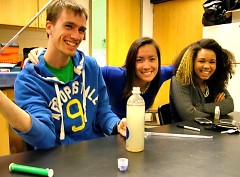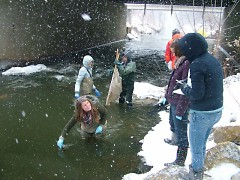Written by David Warners
Historical Plaster Creek
When Plaster Creek was known as Ken-O-Sha ("Water of the Walleye") it followed a meandering course from present day Dutton and Caledonia through wetlands and ravines in Kentwood, over a waterfall of gypsum by Roosevelt Park, eventually meeting up with the Grand River just south of downtown Grand Rapids. This was a beautiful creek marked by huge sycamore, tulip poplar, silver maple and bur oak trees with roots that held the stream’s banks and canopies that cooled the singing waters. The creek supported many types of fish including brook trout, as well its namesake, the walleye. Ken-O-Sha helped to sustain local Ottawa Indians physically and spiritually, and later was a childhood playground for many Grand Rapidians including Charles Belknap, Charles Garfield and Gerald R. Ford. Today the creek is so full of sediment and bacteria that it has been designated as impaired, meaning it is unsafe for children to play in and even to touch.
E. coli in Plaster Creek
How the creek became transformed from a life-giving community asset into a public health hazard is a story that Plaster Creek Stewards is trying to understand and eventually reverse. A main part of that story involves bacteria. One of these bacteria, E. coli, is normally found in the intestines of animals. Since it doesn’t live very long on its own in the environment, E. coli’s presence is used as an indicator of fecal contamination. As far as human health and recreation is concerned, there are three stages of E. coli contamination in water bodies. At the lowest concentrations (zero to 130 E. coli colonies per 100 ml of water) the creek is safe for swimming. At moderate E. coli concentrations (130 – 1000 colonies) the stream is unsafe for swimming, but considered safe for “partial body contact” (ex: fishing from shore). At high concentrations (>1000 colonies), the stream is unsafe for any human contact.
We have consistently found that the levels of E. coli in Plaster Creek are beyond what the State considers safe for both full and partial body contact. On its worst days, E. coli in the stream has reached levels that are 100 times higher than what is considered safe for swimming.
Besides E. coli, there are many other types of bacteria in waterways, much of which is naturally occurring and harmless to humans. But in urban streams like Plaster Creek, it’s not well understood how much of the bacteria in streams is potentially harmful to public health. But high E. coli levels tend to indicate the likely presence of other disease-causing microbes. Yet the presence and abundance of bacteria in public waters like Plaster Creek is not the only issue. Another growing concern is whether or not bacteria in these public waterways are resistant to antibiotics.
What is ARB and where did it come from?
Antibiotic Resistant Bacteria (ARB) are bacteria that continue to thrive even in the presence of antibiotics. ARB will emerge most rapidly when the environment provides an intense and/or consistent exposure to antibiotics. The selection pressure of the antibiotics kills nearly all the bacteria that are susceptible, but those few that survive are the resistant ones, and when they reproduce and eventually recover resistant strains can become dominant, potentially threatening human health.
What do we know?
ARB have only recently become the focus of urban ecology studies. Antibiotic resistant bacteria have been reported in the waterways of Oakland County, and also documented from the Red Cedar River near Lansing. The first effort to look for ARB in Plaster Creek occurred in the spring of 2014, when three groups of Calvin College students focused on ARB for their research projects as part of a Research Methods class (Biology 250). Although each group looked at different bacteria and different antibiotics, they each found ARB in Plaster Creek. In fact, over half the bacteria tested showed resistance to vancomycin, penicillin and tetracycline. The findings from these three studies were combined into one summary report that was submitted to the Kent County Health Department.
How do antibiotics get into our environment?
Humans can introduce antibiotics into the environment if they are taking these drugs and have leaky septic fields. Antibiotics that are disposed of improperly can also make their way into streams and rivers. Water treatment plants have been implicated as a source as well. In addition, livestock treated with antibiotics are the source of manure that contains high levels of these antibiotics, so runoff from feedlots and fertilized fields is also a suspected source. With further research we hope to figure out where the ARB in Plaster Creek is coming from.
Practical Relevance
Since so few studies have been done on ARB in urban streams, we do not know how our findings compare with other urban areas, or even with other urban streams in our region. But our data do suggest that certain forms of ARB are abundant in Plaster Creek and we also found several strains that were resistant to multiple antibiotics. This is a concern because infections caused by ARB cannot be successfully treated with the resistant antibiotic. In other words, if a child gets an infection from contacting Plaster Creek water containing E. coli that is resistant to penicillin, then penicillin will be useless in treating this infection.
What Can Be Done?
Carefully using and disposing of antibiotics is something we should all take very seriously. Recently McDonalds has committed to only purchasing chicken that has not been treated with antibiotics. Encouraging and supporting such decisions, and paying attention to where our food comes from, is also an important contribution we can all make.
At this time, contact with Plaster Creek water is not recommended, particularly when the volume of the creek increases after snowmelt or rainfall. These are the times when E. coli levels are particularly high. Plaster Creek Stewards is focused on learning as much as we can about the bacteria in Plaster Creek, in particular identifying some of the main sources of E. coli as well as better understanding the incidence of ARB in the creek and its origins. Reducing the number of bacteria and particularly ARB in Plaster Creek is a critical step in restoring this stream to where it can once again become a welcome playground and community asset for the residents of southeast Grand Rapids.
The Rapidian, a program of the 501(c)3 nonprofit Community Media Center, relies on the community’s support to help cover the cost of training reporters and publishing content.
We need your help.
If each of our readers and content creators who values this community platform help support its creation and maintenance, The Rapidian can continue to educate and facilitate a conversation around issues for years to come.
Please support The Rapidian and make a contribution today.



